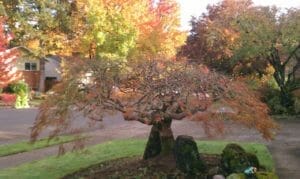In this blog post we continue looking at Portland tree care with an eye towards fall fertilization. We discuss how homeowners can properly fertilize trees in late fall. Read on to learn how to determine if there is a need to fertilize, what not to do, things to look for, and alternative treatments; all to ensure that your trees are as healthy as possible.
Nutrients and Tree Health.
Let’s discuss fertilizer and plant nutrients. It is common knowledge that plants need nutrients to stay healthy, grow, and thrive. If these nutrients are missing or are deficient, the plant will be more susceptible to stress and other associated problems, such as disease and insect predation. Knowing the best time to fertilize trees in Portland, OR, can help ensure that your trees receive the nutrients they need at the right time. Plant nutrients are divided into two categories: micronutrients and macronutrients.
Macronutrients are nitrogen (N), phosphorus (P), and potassium (K), which are also represented by the three numbers you see on fertilizer packaging (18/18/18 fertilizer means it is 18% for each of the three macronutrients, N/P/K). Micronutrients include iron (Fe), manganese (Mn), zinc (Zn), and copper (Cu) among others. Both organic and inorganic fertilizers are available in blends specially formulated for tree and shrub growth. For instance, here in the Pacific Northwest, we do love our azaleas and rhododendrons. These plants thrive in acidic soil conditions and special fertilizers are also available that are formulated for custom azalea and rhododendron treatment. Our Portland certified arborists are happy to provide specific fertilization approaches for your trees; call us for a diagnostic visit.
When to fertilize? Most arborists suggest fertilizing trees either in early-to-mid spring, or in late fall when the trees go dormant. Since fall is here, we will concentrate on late fall fertilizing for this post. Autumn fertilization allows some fertilizer nutrients to be used for root growth, while the rest of the nutrients are stored in plant tissue, ready for use when the plant is actively growing again in spring. Late fall fertilizer application is recommended over early fall application, because early fertilization can encourage root growth. If young roots spurred by fertilizer are not winter-ready, problems can ensue. Additionally, when providing fall fertilization Portland tree services, we recommend applying a third of what you use during other times of the year. This minimalists’ approach will not to overly stimulate roots, allowing the plant to only absorb what it needs.
For those wondering how to prune Japanese maple, it’s important to prune at the right time and avoid heavy pruning in fall, as this can stress the tree when combined with fertilization.
How can you tell when fertilizer is needed? Fertilize if the tree’s foliage is uncharacteristically light green, if it has undersized leaves, or if the canopy is thinning. Also fertilize if you see dieback on the stems or trunks. Trees that are grown in a parking lot or sidewalk strip should also be fertilized, as these specimens often lack access to nutrients. Another classic clue that fertilization is needed is a decline in growth after several years of healthy growth. Finally, a soil test can determine the need to fertilize. Our Portland certified arborists consider soil testing a first, go-to tool for assessing tree fertilization. Home soil testing kits are available, or you can collect a sample yourself and send it to a soil-testing lab. UFP is also available for soil testing services.
When Not to Fertilize Trees.
Newly planted trees do not need fertilizer. Sometimes a plant does not respond well to fertilization. In these cases more fertilizer will not help. Rather than applying fertilizer willy-nilly, it is best to determine the underlining causes of problems. Call us; our arborists are happy to make a home visit.
When Trees are Under Stress. Feeding trees that are under stress is debatable. It is true that a stressed tree needs nutrients to boost pest and disease resistance. However, a tree that is suffering drought stress will not be able to use the fertilizer without adequate water. If water is lacking, the fertilizer could actually damage roots and scorch leaves. Tree stress is complex; as such, it is best to call an ISA-certified arborist before applying fertilizer to stressed trees or performing tree pest control.
When Other Fertilizer is Applied. If you are fertilizing your lawn, and it receives a good amount of rain and/or irrigation, your trees might already be getting the nutrients they need. Check for pests or signs of disease. If you see healthy tree growth, it is not recommend to fertilize.
When Alternative Treatments are Available. Fertilizing is not the only solution, but rather should be seen as part of a comprehensive tree health plan. Other treatments can be used alone or in conjunction with fertilization to maximize the well-being of trees and shrubs.
How to Boost Tree Health without Fertilizer
Aeration.This helps open up compacted soil, and allows oxygen into the pore spaces around the roots, which also facilitates the infiltration of water.
Mulching. This helps protect the tree by increasing water retention and suppressing weeds.
Compost. Compost releases nutrients slowly, sustaining trees and shrubs across seasons. Additionally, compost often contains much-needed micronutrients. The key is to apply it in thin layers, no more than 1/3 of an inch deep.
Contact Our Tree Care Experts for More Tips
Knowing when to fertilize and how to do it can be tricky. Here at UFP we take fertilizing seriously. We are keen to use organic based fertilizer and practices that eschew the use of noxious chemicals. Call us today to learn more about our fertilization program, and how we can help with the overall health of your trees and shrubs. Contact Urban Forest Pro for tree removal, tree pruning, stump grinding, and emergency tree removal near you in Portland.